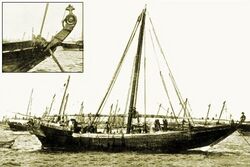Engineering:Ghanjah

A ghanjah or ganja[1] (Arabic: غنجه), also known as kotiya in India , is a large wooden trading dhow, a traditional Arabic sailing vessel.[2]
Description
The ghanjah dhows had a curved prow with a characteristic trefoil ornament carved on top of the stem-head. They also had an ornately carved stern and quarter galleries. Their average length was 97 ft (30 m) with a 15 m (49 ft) keel-length and an average weight of 215 tons. Usually they had two masts, the main mast having a pronounced inclination towards the prow. They used two to three lateen sails; supplementary sails were often added on the bowsprit and on a topmast atop the main mast.[3]
The ghanjah is often difficult to distinguish from the baghlah, a similar type of dhow. Besides the trefoil-shaped carving on top of the stem-head, ghanjahs usually had a more slender shape.[4]
History
Ghanjahs were widely used in the past centuries as merchant ships in the Indian Ocean between the western coast of the Indian subcontinent and the Arabian Peninsula.[5] Many ghanjahs were built at traditional shipyards in Sur, Oman,[6] as well as in Beypore, Kerala, India.
Ghanjahs were largely replaced by the newer-designed and easier to maneuver booms in the 20th century.
See also
References
- ↑ Thabit A. J. Abdullah, The Political Economy of Trade in Eighteenth-Century Basra, SUNY series in the Social and Economic History of the Middle East , 2000, ISBN:978-0-7914-4808-3
- ↑ Clifford W. Hawkins, The dhow: an illustrated history of the dhow and its world
- ↑ Too Late to Document Dhows?
- ↑ The Traditional Dhow
- ↑ Gardiner, Robert (2001 [1998]). The Victory of Seapower. Caxton Editions. ISBN:1-84067-359-1. p. 89
- ↑ The Traditional Dhow
External links
- Ghanjah and baghlah
- Hikoichi Yajima, The Arab dhow trade in the Indian Ocean : preliminary report
- Dhows
- The Historic Dhow
- The Dhow of Racing
 |


